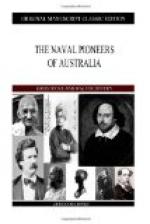CHAPTER II.
DAMPIER: THE FIRST ENGLISHMAN IN AUSTRALIA.
“I dined with Mr. Pepys, where was Captain Dampier, who had been a famous buccaneer, had brought hither the painted Prince Job, and printed a relation of his very strange adventure and his observations. He was now going abroad again by the King’s encouragement, who furnished a ship of 290 tons. He seemed a more modest man than one would imagine by the relation of the crew he had consorted with. He brought a map of his observations of the course of the winds of the South Sea, and assured us that the maps hitherto extant were all false as to the Pacific Sea, which he makes on the south of the line, that on the north and running by the coast of Peru being I exceedingly tempestuous.”
Thus wrote John Evelyn on August 6th, 1698.
Of the adventurous career of Dampier prior to this date too much fiction and quite enough history has already been written; but we cannot omit a short account of the buccaneer’s life up to the time of his receiving King William’s commission.
Dampier was born in 1652 at East Coker, [Sidenote: 1673-1698] Somersetshire. Of his parents he tells us that “they did not originally design me for the sea, but bred me at school till I came of years fit for a trade. But upon the death of my mother they who had the disposal of me took other measures, and, having removed me from the Latin school to learn writing and arithmetic, they soon placed me with a master of a ship at Weymouth, complying with the inclinations I had very early of seeing the world.”
Dampier made several voyages in merchantmen; then he shipped as able seaman on the Royal Prince, Captain Sir Edward Spragge, and served under him till the death of that commander at the end of the Dutch war in 1673. Soon after he made a voyage to the West Indies; then began an adventurous life—ashore cutting logwood in the Bay of Campeachy when not fighting; afloat a buccaneer—of which he has given us details in his Voyage round the Terrestrial Globe.
In March, 1686, Dampier in a little barque, the Cygnet, commanded by Captain Swan, quitted the American coast and sailed westward across the Pacific. On this voyage the Cygnet touched at the Ladrones, the Bashee Islands, the Philippines, Celebes, Timor, New Holland, and the Nicobar Islands. Here Dampier left his ship and worked his way to England, which he reached in 1691. (The Cygnet was afterwards lost off Madagascar.) He had brought home with him from Mindanao a tattooed slave, whom he called the “Painted Prince Jeoey,” and who was afterwards exhibited as the first painted savage ever seen in England. “Jeoey,” who died at Oxford, is the “painted Prince Job” mentioned by Evelyn.
It has been stated that the Cygnet touched at New Holland. This land was sighted on January 4th, 1688, in what Dampier says was “latitude 16.50 S. About three leagues to the eastward of this point there is a pretty deep bay, with abundance of islands in it, and a very; good place to anchor in or to haul ashore. About a league to the eastward of that point we anchored January the 5th, 1688, two miles from the shore.”




